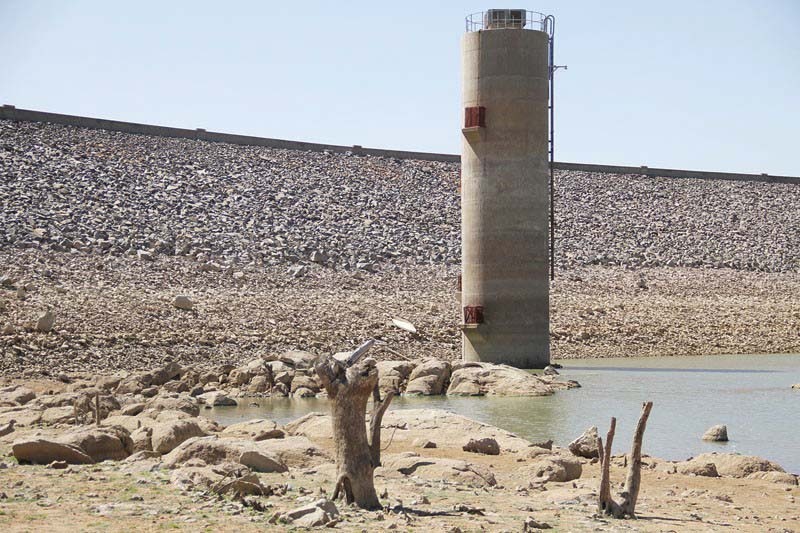Botswana to cross critical temperature threshold in less than a decade
Correspondent | Friday May 4, 2018 13:40


When ecologist Ephias Mugari visited the Bobirwa area in eastern Botswana in February 2018, the region was in the grip of a long drought. It was the height of summer, and many of the farmers he met still hadn’t planted any crops. The rains were three months late.
A year earlier, a colleague visited the Onesi region in northern Namibia, about 2,000 km north-west of here, and found the rural villages bustling with Angolans who had crossed the border, desperate for work. The drought that had started in 2013 still hadn’t broken, and their small farms could no longer support the Angolan families that lived on them. So people drifted away from their homes, looking for piecemeal jobs as domestic cleaners or farm labourers in Namibian villages where the local economies were a little more resilient. They were happy to be paid in cash or food. Mugari, a doctoral researcher at the University of Botswana (UB) , is part of a group of researchers that is collaborating through a unit called Adaptation at Scale in Semi-Arid Regions. They’re looking for clues to how the climate is changing in some semi-desert parts of southern Africa, and how communities and governments should respond, so that that people living in these rural parts can absorb the kinds of environmental shocks that will hit drier parts of southern Africa as conditions warm and dry in future.
What Mugari and his fellow researchers noted in their visits to these remote parts of both Botswana and Namibia through the course of this most recent drought, is that when people’s farms fail, they either lean more heavily on the natural environment for other ways to source food and livelihood options. Or they leave their farms and go off in search of alternative sources of work, often in nearby towns or cities.
It’s about water and agriculture
Tiro Nkemelang, meanwhile, is a climate scientist based at the Botswana Institute of Technology Research and Innovation (BITRI). While Mugari and the rest of the ASSAR crew were out in the countryside looking at how people were coping with the drought, Nkemelang was busy analysing climate models to see how much worse things are likely to get in drier southern Africa in future, as global temperatures continue to rise.
His findings show that Botswana is expected to heat up significantly faster than many other parts of the globe, as atmospheric carbon dioxide pushes up global temperatures.
‘Botswana is already a semi-desert country,’ Nkemelang says, ‘and because of its relative distance from any oceans or expanses of tropical forest, it won’t benefit from the way these large humid areas slow the global warming effect a bit. Places like the Sahara are also likely to warm faster, for the very same reason.’ For two decades, the United Nations Intergovernmental Panel on Climate Change (UNIPCC) has structured its international negotiation efforts around two temperature thresholds: the objective has been to keep global temperatures from exceeding either 2°C, relative to pre-industrial temperatures, or preferably keeping them below 1.5°C. From Nkemelang and colleagues’ analysis of 31 climate models, they found that when the global temperature reaches the 1.5°C temperature increase above pre-industrial levels, Botswana could already be much warmer than that.
Researchers expect that Botswana may already have crossed the 2.0°C temperature mark by as soon as 2024.
‘The models show that for Botswana, periods of drought are expected to last longer, with fewer rainfall events breaking them,’ says Nkemelang, ‘but when the rain events do come, they are likely to be more intense, possibly resulting in flooding. However the overall climate trend will be one that is hotter and drier.’
Namibia is expected to see similar overall warming and drying. More severe droughts with shortened and less predictable rain seasons will have significant impact on crop yields and food availability. Communities like those in Bobirwa (Botswana) and Onesi (Namibia), where Mugari and colleagues visited, are highly dependent on rain to keep their agricultural productivity up. They also have to lean heavily on the natural environment for wild-harvested food, fodder for their livestock, materials like timber and fuel, and also water. Any changes in climate that might impact on rainfall, bring extreme events like heatwaves or droughts, or change fire regimes, can undermine vegetation health and agricultural yields.
Nkemelang’s analysis only focused on Botswana, and showed that this particular country will see the climate system warming faster than most other places on the globe. However, the take-home message for policymakers across these semi-desert parts of the region, the ASSAR team says, is that communities and governments need to start moving towards adapting to these current and future climate change impacts.
‘Climate-smart agricultural practices will help the agriculture sector adapt, as it is likely to be most severely affected,’ Nkemelang recommends.
This might include installing drip irrigation in cultivated lands, using animal traction technology instead of tractors, switching from traditional millet to an early-maturing form of pearl millet, or farming with rice which is not traditional to the region. Adopting livestock breeds that are drought-resilient is another possible approach. “Policymakers also need to be strategic in planning for future water security. They can do this through encouraging rain water capture and water saving measures in preparation for potentially long drought periods that are expected to increase in frequency.”Given the infancy of climate research in sub-Saharan Africa including Botswana and Namibia, Nkemelang says there needs to be greater investment in this area, in order to increase the countries’ knowledge base on climate change, and then inform appropriate evidence-based policy development.
*Leonie Joubert is a South African science writer and author. This article was funded by ASSAR (Adaptation at Scale in Semi-Arid Regions), a research consortium looking at climate change in semi-arid parts of Africa and India. The article is the first of a six-part series Mmegi will be running
